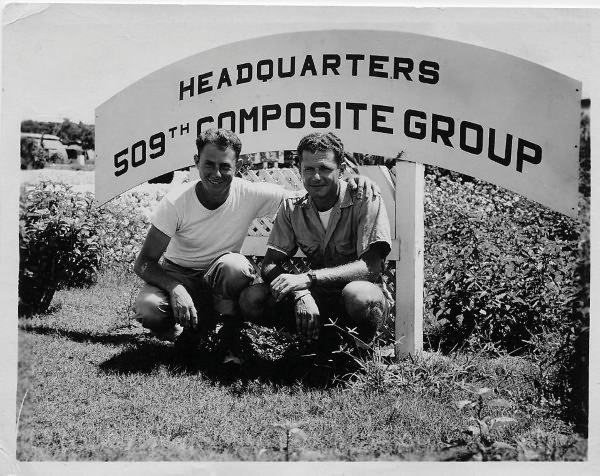“I could not see very much of the city, but I could see this cloud coming up. It shot past our altitude. Inside the center of the core of the mushroom was this boiling cauldron of salmon-colored pink flame,” said co-pilot Fred Olivi, describing the sight of the atomic explosion over Nagasaki on August 9, 1945. The Atomic Heritage Foundation (AHF) is pleased to present the 509th Composite Group Collection, courtesy of official 509th historian Joseph Papalia, who has maintained close friendships with many veterans of the group. The collection, which is featured on the “Voices of the Manhattan Project” website, showcases more than a dozen exclusive interviews and oral histories.
The 509th Composite Group was an array of ordinary soldiers trained to perform a secret and critical mission: dropping the atomic bombs. Assistant flight engineer Ray Gallagher, who flew on Bockscar, the plane that carried the Fat Man plutonium bomb on the Nagasaki mission, summed up the emotions the crew felt before the mission. “We all get on and we are all heroes. But then, when you sit in your own little individual spot and you have your own self to think about, even though everybody will help one another, I can say without a doubt, everybody is scared. But as a group, we are brave.”
The members of the 509th were unaware of the purpose of their training. “We knew we were working on something really important. But no one actually could determine what it was,” remarked radio operator Abe Spitzer. Even after Colonel Paul Tibbets, just before the missions, revealed that the 509th’s purpose was to drop devastatingly powerful bombs, the word “atomic” was never used.
Enola Gay tail gunner Bob Caron was the only person to guess at the true nature of the bombs. “I said, ‘Colonel, is this a physicist’s nightmare?’ He gave me a funny look and he says, ‘You might call it that.’ I said, ‘Colonel, are we splitting atoms this morning?’”
Many of the 509th veterans remember feeling a sense of relief after the completion of the Hiroshima mission. Radio operator Richard Nelson recalled his exact emotions at the time as “a feeling of elation. We all felt this had ended the war. I think we were surprised when a second drop was necessary.” Nelson was not alone in his shock, as many other 509th members were confident that the second mission would not happen.
However, despite their surprise, the 509th veterans almost uniformly did not regret their role in history. Years later, Charles Sweeney, the commander of the Nagasaki mission, expressed his feelings on the morality of atomic warfare. “My personal attitude was, ours is not to question why, but to do or die.” Gallagher, however, was more reflective. “As you get into your years and you see pictures of these different situations and people at the memorials, your heart goes out and you say, why did it happen? But it had to happen.”
Radar countermeasures officer Jacob Beser was the only person to be on the strike plane on both missions. He visited Hiroshima years after the atomic bombings, on the invitation of the Japanese government. He was the only member of the 509th to do so. Although he did not have qualms about flying on planes that dropped atomic weapons in wartime, he did admit that the U.S. government made certain oversights.
In his interview, Beser said, “Eighty-five percent of the survivors within three thousand feet of the explosion suffered some form of radiation disease. This is something that people ask – didn’t we know, didn’t we anticipate? We did not know the extent. We did anticipate that anybody within a radius of several hundred feet would be hurt badly by radiation, but would also either be blown to hell or burned. So as a separate entity and as a prolonged aftereffect, we were a little naïve.”
These powerful interviews will provide valuable resources for educators, historians, students and anyone interested in the history of these era-defining missions and the people involved. For these interviews with members of the 509th and more reflections on the atomic missions, visit “Voices of the Manhattan Project.”
AHF also features historic photographs and profiles of over one thousand members on the 509th Composite Group on the AHF website.
This project was made possible by Joseph Papalia who shared his recordings with members of the 509th. AHF is also very grateful to Crystal Trust for their generous financial support for our oral history projects.





